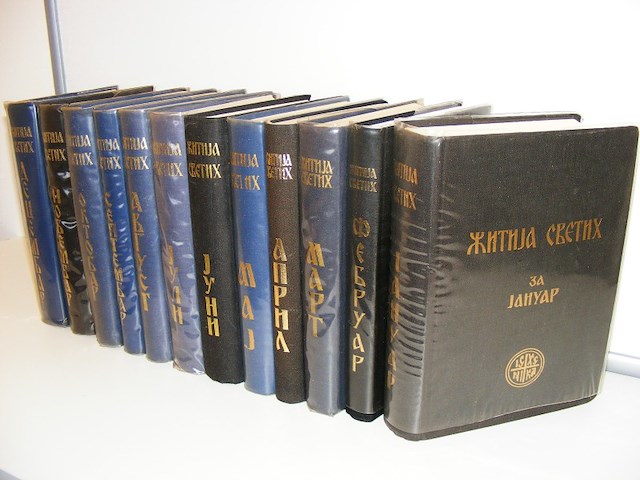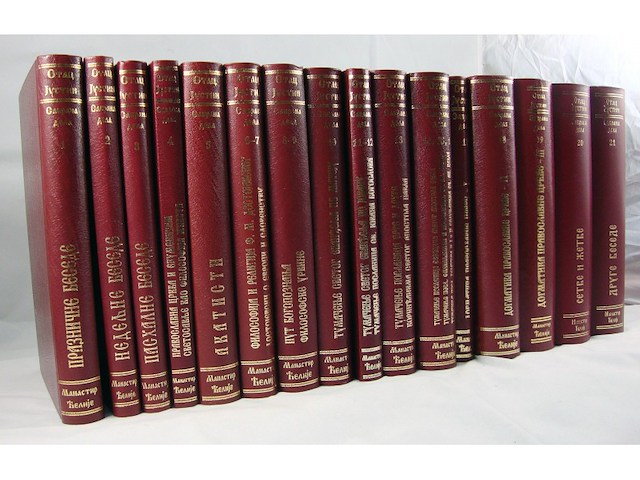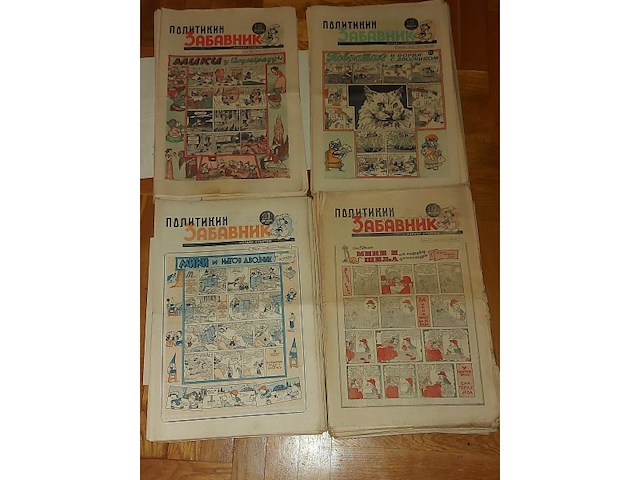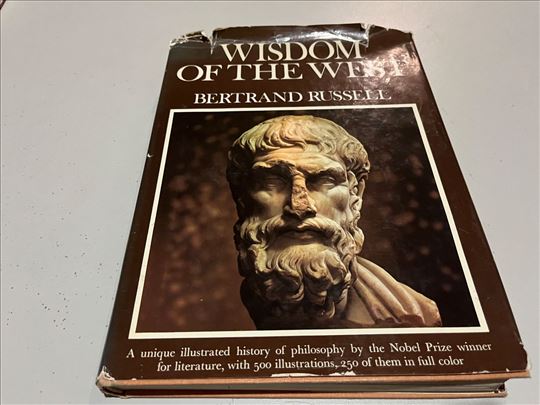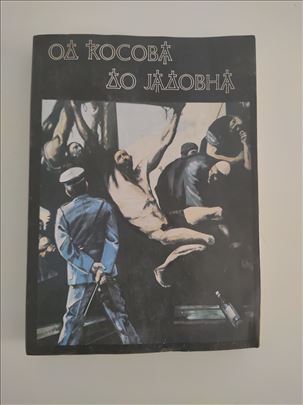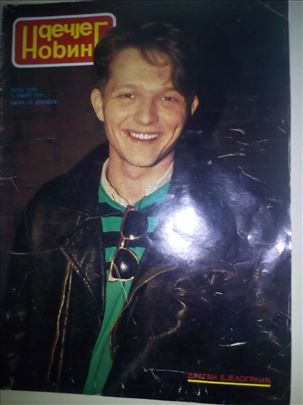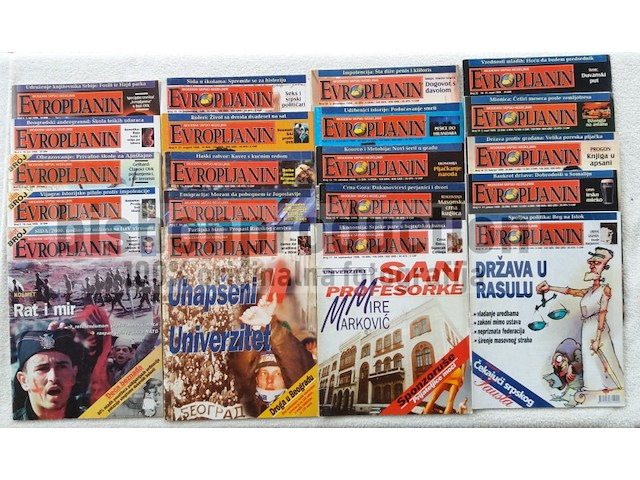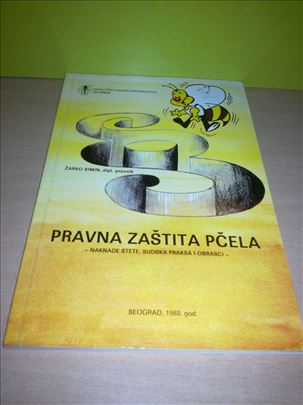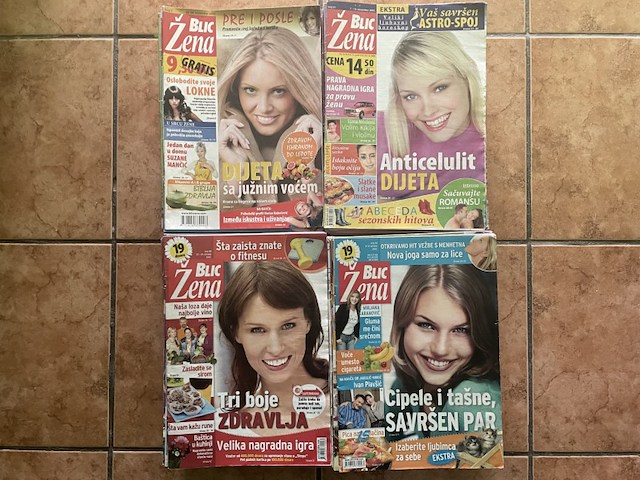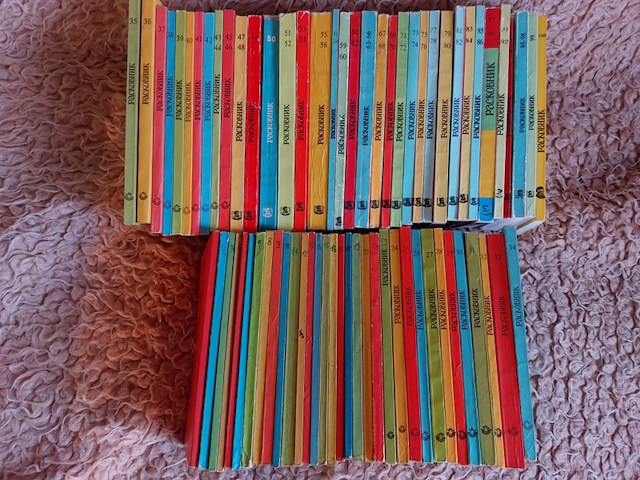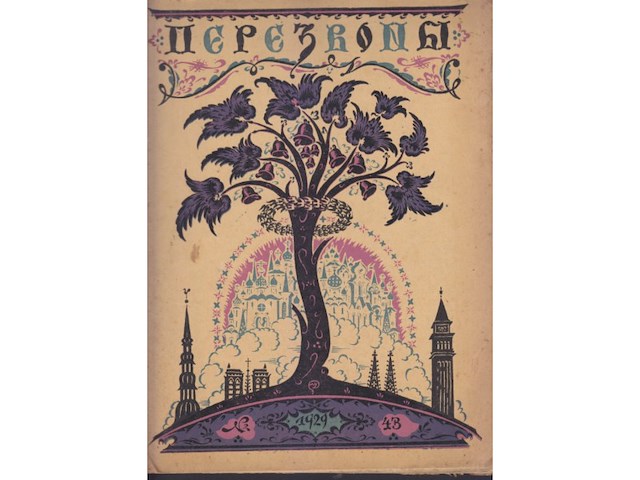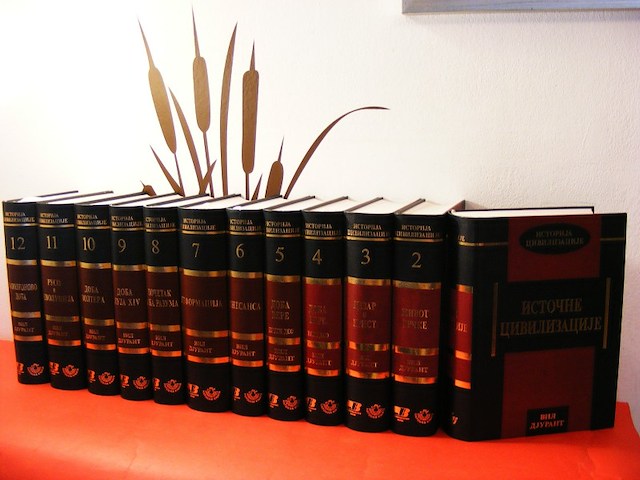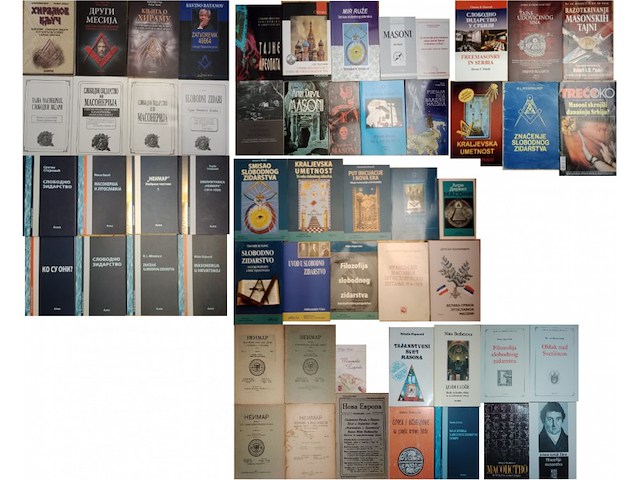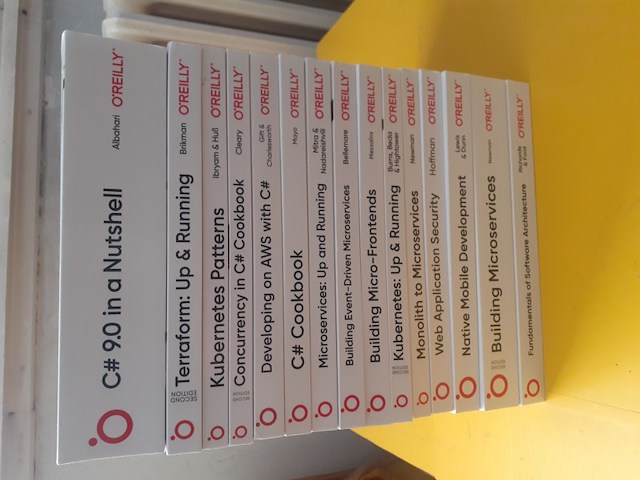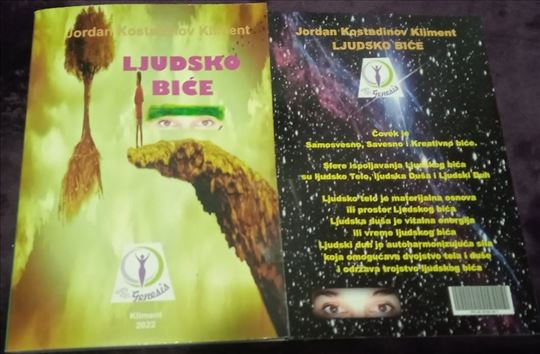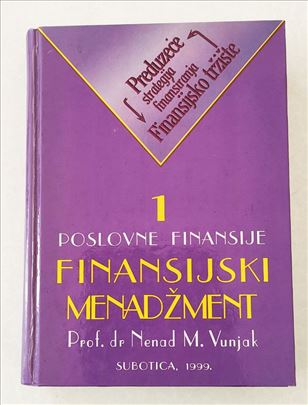Pratite promene cene putem maila
- Da bi dobijali obaveštenja o promeni cene potrebno je da kliknete Prati oglas dugme koje se nalazi na dnu svakog oglasa i unesete Vašu mail adresu.
1-25 od 102 rezultata
Režim promene aktivan!
Upravo ste u režimu promene sačuvane pretrage za frazu .
Možete da promenite frazu ili filtere i sačuvate trenutno stanje
Aktivni filteri
Ava Justin Popović Žitija svetih 1-12 komplet S blagoslovom Nj.P.Episkopa Šabačkovaljevskog Gospodina Jovana BLAGOSLOV SVETOG ARHANĐELA MIHAILA ŽITIJA SVETIH arhimandrit D-r Justin Sp.Popović bivši profesor univerziteta Izdanje Manastira Sv. Ćelije kod Valjeva Beograd 1972/1977. Tvrd povez, plastificirani zaštitni omot, ćirilica, ilustrovano. Prvo izdanje-11 knjiga , dok je februar izdanje 2005. Svaka knjiga ima originalni list sa štamparskim pogreškama, Na predlistu prve knjige pečat manastira Jošanice sa posvetom igumana. Posveta na prvoj strani predgovora. -žitija svetih za januar, strana 901 -žitija svetih za februar, strana 466 -žitija svetih za mart, strana 585 -žitija svetih za april, strana 486 -žitija svetih za maj, strana 657 -žitija svetih za jun, strana 693 -žitija svetih za jul, strana 743 -žitija svetih za avgust, strana 536 -žitija svetih za septembar, strana 613 -žitija svetih za oktobar, strana 695 -žitija svetih za novembar, strana 846 -žitija svetih za decembar, strana 877 Stanje Veoma dobro, kao novo, na dve knjige nedostaje plastificirani zaštitni omot,knjige su odlično očuvane.
Na jednom mestu sva dela Svetog Justina Ćelijskog. Sabrano u 19 knjiga, bordo boje, tvrdog poveza sa zlatotiskom. Preko 10.000 stranica! Izdaje Manastir Ćelije, Valjevo. Veličina knjige je 24cm. Prodaje se kao komplet. Moguća kupovina na čekove, kreditne kartice, pay pal... Šaljem u inostranstvo! Evo i naslova: 1. Knjiga I - Praznične besede 2. Knjiga II - Nedeljne besede 3. Knjiga III - Pashalne besede 4. Knjiga IV - Pravoslavna crkva i ekumenizam / Svetosavlje kao filosofija života 5. Knjiga V - Akatisti 6. Knjiga VI-VII - Filosofija i religija F.M. Dostojevskog / Dostojevski o Evropi i Slovenstvu 7. Knjiga VIII-IX - Put Bogopoznanja / Filosofske urvine 8. Knjiga X - Tumačenje Svetog Evanđela po Mateju 9. Knjiga XI-XII - Tumačenje Svetog Evanđela po Jovanu / Tumačenje Poslanica Svetog Jovana Bogoslova 10. Knjiga XIII - Tumačenje Poslanica prve i druge Korinćanima Svetog Apostola Pavla 11. Knjiga XIV-XV-XVI - Tumačеnjе Poslanicе Svеtog Apostola Pavla: Efеscima, Filipljanima i Kološanima, Galatima i I i II Solunjanima 12. Knjiga XVII - Dogmatika Pravoslavne Crkve I 13. Knjiga XVIII - Dogmatika Pravoslavne Crkve II 14. Knjiga XIX - Dogmatika Pravoslavne Crkve III 15. Knjiga XX - Setve i žetve 16. Knjiga XXI - Druge besede 17. Knjiga XXII - Zapisi, dnevnici, manja dela 18. Knjiga XXIII/I - Besede I 19. Knjiga XXIII/II - Besede II
-
Kolekcionarstvo i umetnost chevron_right Knjige
Istorija s povodom članci objavljeni u Nedeljniku "vreme" 2007/2008 godine Zorica Janković lok81
-
Kolekcionarstvo i umetnost chevron_right Knjige
Naslov: Ugovor o prodaji u anglosaksonskom pravu Autor(i): Maša Mišković Izdavač: Pravni fakultet Mesto: Beograd Godina: 2014 Povez: mek Strana: 133 Format: 20 cm Pismo: ćirilica Stanje knjige: kao novo - nekorišćeno Kupac snosi troškove slanja. Lično preuzimanje (Beograd-centar). Tada je i plaćanje lično.
-
Kolekcionarstvo i umetnost chevron_right Knjige
Wisdom of the west Bertrand Russell
-
Kolekcionarstvo i umetnost chevron_right Knjige
Dobra ima malo znakova korišćenja 583 grama 367 strana
-
Kolekcionarstvo i umetnost chevron_right Knjige
Dečje novine - Dragan Bjelogrlic - Nindza Kornjace Veoma retko i raritetno izdanje iz 1991. godine. Teme: Na tragu prirode. Siroko Srce. Priroda i drustvo. Kalendar istorijskih dogadjaja. Odabrane price, pesme... Grigor Vitez. Mitska bica nasih predaka. Mitovi i legende - Antlantida, el Dorado. Kultura ponasanja. Sa nasim reporterom po Svetu. Kompjuterski leksikon. Pronalasci za civilizaciju. Strip pokretna konjusnica. Spomenak. Stubac Zaljubac. Skoloskop. Astrologija. Sport - Robert Prosinecki natrazeniji fudbaler evrope, nasi najbolji u skoku u vis. Saobracaj. Eureka: Smeh divljeg Zapada. Misaone igre: Ukrstene reci, osmosmerka, skriveni crtez, lavirint, rebus uoci razliku, morske ribe u osmosmerci...
Ava Justin Popović Žitija svetih 1-12 komplet S blagoslovom Nj. P. Episkopa Šabačkovaljevskog Gospodina Jovana BLAGOSLOV SVETOG ARHANĐELA MIHAILA ŽITIJA SVETIH arhimandrit D-r Justin Sp. Popović bivši profesor univerziteta Izdanje Manastira Sv. Ćelije kod Valjeva 1998. godina, Štampa. . . Beograd -Novi Dani Tvrd povez , ćirilica, ilustrovano. ,25. cm. Knjige u PERFEKTNOM stanju. . . . . -------------------------------- 1. ŽITIJA SVETIH za januar, strana 901 2. ŽITIJA SVETIH za februar, strana 466 3. ŽITIJA SVETIHza mart, strana 585 4. ŽITIJA SVETIH za april, strana 486 5. ŽITIJA SVETIH za maj, strana 657 68. ŽITIJA SVETIH za jun, strana 693 7. ŽITIJA SVETIH za jul, strana 743 8. ŽITIJA SVETIH za avgust, strana 536 9. ŽITIJA SVETIH za septembar, strana 613 10. ŽITIJA SVETIH za oktobar, strana 695 11. ŽITIJA SVETIH za novembar, strana 846 12. ŽITIJA SVETIHza decembar, strana 877 Knjige u PERFEKTNOM stanju..... ------------------------------- Moguća kupovina . . . . . . . . , pay pal. . . Šaljem u inostranstvo! -------------------------------- Komplet....
Komplet svih 20 brojeva prvog pravog (po meni i jedinog) news magazina u Srbiji - `Evropljanin`-a. Tačan presek društva s kraja devedestih, bogato ilustrovan i za to vreme neverovatno kvalitetno štampan. Zadnjih 6 brojeva su bili zabranjeni za distribuciju u Srbiji, kupovani su `ispod ruke`. Dream team Srpskog novinartva: Bujošević, Tirnanić, Tijanić, Prpa, Smajlović, Žanetić, Ćuruvija, Mamula i mnogi drugi. Nepunih mesec dana po izlasku poslednjeg broja osnivač i izdavač Slavko Ćuruvija je ubijen. Tekstovi koji i dan danas provociraju. Stanje je solidno, vidljivi znaci korišćenja, sasvim čitljivo. Plaćanje - lično ili uplata na tekući račun + troškovi dostave Ne šaljem pouzećem niti u inostranstvo. Za sva pitanja stojim na raspolaganju
Jevanđelje za bogoslužbenu upotrebu, obloženo najfinijom goveđom kožom. Ručni rad majstora. VREME IZRADE: 7-10 radnih dana OKOV: umetnička livnica Šeli-srpska tradicija, Aranđelovac KNJIŽNI BLOK: Eparhija Žička, svakodnevno, bogoslužbeno, na srpskom. DIMENZIJE: 310*220*80 mm TEŽINA: ~ 4kg Dostava na adresu u Srbiji i 65 zemalja sveta. Besplatna dostava ukoliko se uplata vrednosti knjige obavi pre slanja paketa. Možete poručiti graviranje teksta posvete ukoliko ovaj artikal prilažete nekom od hramova SPC ili poklanjate prijatelju.
-
Kolekcionarstvo i umetnost chevron_right Knjige
Tajne japanske astrologije KIGAKU Znati kako upravljati sopstvenim telom i zdravljem, znati kako urediti odnose sa ljudima, i znati kako usmeriti sreću i sudbinu, tri su umeća koja će biti sudbonosna za vreme koje je pred nama. Rak, nova bolest sida, stres, duševna nestabilnost, u nastupajućem vremenu najviše će pretiti našem telu i duhu. Da izbegnemo bolesti i sačuvamo stabilnost duha, poslužiće nam znanje o devet zvezda – kjusei, koji se jednostavno naziva KIGAKU. Ljudi ne mogu ni da žive ni da rade sami. U svim sredinama u kojima provode vreme sa nekim, harmonija je veoma važna. Nebeska energija, primljena rođenjem, prati nas kroz čitav život i u svim njegovim vidovima. Energija drugihje takođe uvek sa njima, tako da, kada se susrećemo sa ljudima, potiranje te energije, njeno pojačavanje ili jednostavno mimoilaženje, određuje godina i vreme kad smo se rodili. Da li smo izabrali dobre životne saputnike, dobre saradnike, da li se družimo sa pravim ljudima i kakve su nam zajedničke sudbine predodređene, može nam otkriti jedna od nauka „devet zvezda“ – KIGAKU. Da pronađete najboljeg partnera za ljubav, brak, druženje, putovanje, zajednički rad, zabavu, pomaže vam drevna japanska knjiga KIGAKU. 1100 Din
-
Kolekcionarstvo i umetnost chevron_right Knjige
pravna zaštita pčela - naknada štete, sudska praksa i obrasci - žarko simin (autor) izdavač: savez pčelarskih organ. srbije i. pravna zaštira pčela ii. držanje i gajenje pčela iii. naknada prouzrokovane štete iv. o kvalitetu meda kao životne namirnice... obrasci (tužba, žalba, revizija), spisak propisa... ilustracije, latinica, 64 str,1988; knjiga je nova
Enciclopaedia Britannica 1-30 komplet Britannica Encyclopaedia Macropaedia Knowledge In Depth 15th Edition 1982 Encyclopedia Britannica, 15th Edition 30 Vol. Macropaedia Knowledge in Depth printed in USA Language: English Condition:Very Good I 1 Aalto Arithmetic, strana 1178 II 2 Arizona Bolivar, strana 1208 III 3 Bolivia Cervantes, strana 1186 IV 4 Ceylon Congreve, strana 1132 V 5 Conifer Ear Diseases, strana 1138 VI 6 Earth Everglades, strana 1142 VII 7 Evidence Georgian S.S.R. strana 1135 VIII 8 Geraniales Hume , strana 1194 IX 9 Humidity Ivory Coast, strana 1187 X 10 Jackson Livestock , strana 1287 XI 11 Livingstone Metalwork, strana 1119 XII 12 Metamorphic New Jersey, strana 1100 XIII 13 Newman Peisistratus, strana 1110 XIV 14 Peking Probability, strana 1115 XV 15 Proboscidea Rubber, strana 1183 XVI 16 Rubens Somalia, strana 1062 XVII 17 Sonar Tax Law, strana 1087 XVIII 18 Taylor Utah , strana 1106 XIX 19 Utilitarianism Zwingli, strana 1180 XX Propedia Outline of Knowledge / Guide to the Britannica, str.931 XXI I A Bib Micropaedia Ready Referecce and Index, strana 1048 XXII II Bibai Coleman, strana 1050 XXIII III Colemani Exclusi, strana 1023 XXIV IV Excom Hermosil, strana 1050 XXV V Hermoup Lally, strana 1002 XXVI VI Lalo Montpar, strana 1026 XXVII VII Montpel Piranesi, strana 1026 XXVIII VIII Piranha Scurfy, strana 1002 XXIX IX Scurlock Tirah, strana 1025 XXX X Tirane Zywny Addenda, strana 1060. ----------------------------------------------- Veliki enciklopedijski format, tvrd kožni povez, zlatotisk. Stanje Veoma dobro. STANMARE
Prodajem 797 izuzetno dobro očuvanih Politikinih zabavnika: 1978. - 1 primerak; 1997. - 1 primerak; 1998. - 1 primerak; 2002. - 1 primerak; 2003. - 7 primeraka; 2004.- 2 primerka; 2005. - 3 primerka; 2006.-3 primerka; 2007.-24 primerka; 2008.-kompletna godina od 52 primerka; 2009.-kompletna godina; 2010.-kompletna godina; 2011.-kompletna godina; 2012.-kompletna godina; 2013.-kompletna godina; 2014.-kompletna godina;2015.-kompletna godina; 2016.-47 primeraka; 2017.-49 primeraka;2018.-50 primeraka; 2019.-50 primeraka; 2020.-kompletna godina; 2021.-39 primeraka; 2022.-kompletna godina; 2023.-kompletna godina Cena je 50000 dinara. Cena kolekcije kompletiranih godina (od 2008. do 2015.) iznosi 40000 dinara. Cena pojedinačne kompletne godine je 5000 dinara. Ne prodajem pojedinačne brojeve.
Posebno mesto među izvorima hrišćanske vere pripada Žitijama Svetih. Pod ovim nazivom se podrazumevaju dela duhovne literature u kojima su sabrani i opisani životi svetih ličnosti, njihovo proslavljanje od Boga, kao i događaji čiji spomen Crkva praznuje, premda je posve sigurno da Sabor Sveti čine i oni čiji životi nisu zapisani. Žitija Svetih, po rečima o. Justina Popovića, «predstavljaju život Gospoda Hrista koji se ponavlja u životima Svetih», budući da Crkva, i sve u njoj, odražava život Gospoda Isusa Hrista. Svetitelji su u sebe duboko urezali Hristov lik i zato ih verni u Crkvi doživljavaju kao istinske svedoke prave vere. Komplet sadrži 12 knjiga koje su podeljene po mesecima (januar, februar, mart…), tvrdog su poveza sa zlatotiskom. Preko 5000 stranica! Težina upakovanog paketa je 16kg! Moguća kupovina na čekove, kreditne kartice, pay pal... Šaljem u inostranstvo! Pre kupovine me kontaktirajte radi detalja prodaje.
ovo je lot od 32 broja ruskog knjizevno - umetnickog casopisa PEREZVONI (zvona) tacnije 31 sveska - brojevi 7 i 8 su izasli kao dvobroj ruska emigracija u latviji - riga izdavac : salamander naslovna strana : ilustracija M. Dobuzhinsky format : 29,5 x 22,5 cm, tezina oko 4 kg stanje lose. nedostaju pojedine reprodukcije, fleke nepoznato mi je koliko je brojeva izaslo. ovde (od 1 do 43) nedostaju brojevi : 1,3,9,12,14,18,20,23,25,26,30 i 33. rusija, emigracija,periodika samo srbija ove casopise ne saljem u inostranstvo serbia only I do not send these magazines abroad ---------------------------------- Било је потребно да прође стотину година да бисмо почели да се занимамо за Русе који су после 1918. дошли у наш град. Њихов утицај на развој друштва, науке, образовања и културе био је велики и зато је важно да сада, када је јавност заинтересована за ову тему, сазнамо праве чињенице о руској емиграцији у Србију. Велику победу у Првом светском рату Србија је несразмерно скупо платила јер се процењује да смо изгубили чак око 60 одсто мушке популације, између 1,1 и 1,3 милиона људи, односно трећину укупног становништва. Таква изнурена, рањена и сељачка Србија ушла је 1918. године неспремна у државну заједницу са Словенијом и Хрватском, које нису претрпеле ратна разарања и биле су привредно напредније. Сматра се да је око два милиона Руса напустило своју земљу после Октобарске револуције и пораза у грађанском рату. Око 40.000 дошло их је у Краљевину Срба, Хрвата и Словенаца, највише у Београд и друге веће српске градове. Краљ Александар је руске емигранте дочекао раширених руку због посебног односа са убијеним руским царем Николајем, који му је био кум. Уосталом, и краљ и принц Ђорђе били су руски кадети, а прича се да је Олга, једна од кћерки цара Николаја, била обећана југословенском монарху за супругу. Какав је однос руска царска породица имала према Александру Карађорђевићу говори и чињеница да је Марија Фјодоровна, мајка цара Николаја, завештала југословенском монарху икону Пресвете Богородице Филермоса, коју је насликао свети апостол Лука, шаку Светог Јована Крститеља и делић Часног крста. Те светиње предате су краљу Александру 1928. године после смрти руске царице у Копенхагену, а чуване су у посебној крипти на Белом двору. О структури руских емиграната сведоче подаци које је објавио Николај Степанов, дипломирани историчар Државног универзитета у Нижњем Новгороду. Он наводи да је само на једном од бродова који је упловио у Боку било 30 генерала, професора, доктора. Према Степанову, више од половине придошлих Руса били су војна лица и државни службеници, око 30 одсто радило је у привреди, а 14 одсто су били предавачи, доктори, писци, свештенство и уметници, уз пет одсто административног кадра. Према овим подацима, њих 13 одсто имало је високу стручну спрему, а само три одсто било је без икаквог образовања. Веома брзо је на чело универзитетских катедри у Краљевини дошло чак 28 руских професора. Руски професори чинили су четвртину наставног кадра Београдског универзитета, а на Пољопривредном и Медицинском факултету чак половину. Основали су интерну клинику Медицинског факултета. Својој новој домовини Руси су дали дванаест акадмика Српске академије наука, попут Георгија Острогорског, једног од највећих византолога двадесетог века. Руски уметници обновили су балет и оперу Београдског народног позоришта, а најзначајнији су балерина Нина Кирсанова и сценограф Владимир Ждерински. Прву глумачку школу отворио је редитељ Јуриј Ракитин. Утицаји Ђорђа Лобачева на развој српског стрипа, Константина Константиновича Егера на развој мачевања, или сликара Степана Фјодоровича Колесникова на наше сликарство, били су непроцењиви. У Београду је радило више од педесет руских архитеката, међу којима су најзначајнији Николај Краснов, Сергеј Смирнов, Василиј Баумгартен, Јуриј Коваљевски, Роман Верховски, Валериј Сташевски и Василиј Андросов. Они су пројектовали велики број јавних зграда које постоје и данас, попут зграда Главне поште, Владе Србије, Министарства иностраних послова, старог Генералштаба, Белог двора, Патријаршије, Руског дома, Цркве Александра Невског и Цркве Свете Тројице. У Београду су издавани и превођени модерни руски писци као што су Борис Пиљњак, Данил Хармс, Иљф и Петров, који су били забрањени у СССР-у. За претежно неписмену земљу, чија половина становништва није знала да чита и пише, то свакако није била мала ствар. Рецимо, у Србију је дошло између 1.200 И 1.500 инжењера, а имали смо их око 500. Први декан машинског факултета био је академик Владимир Фармаковски. Први шеф пилота домаће авио-компаније „Аеропут“, претече ЈАТ-а и „Ер Србије“, био је Владимир Стрижевски, а за ту компанију летели су многи руски пилоти попут Михаила Јарошенка, Виктора Никитина и Леонида Бајдака. Бајдак је заједно са Тадијом Зондермајером 1927. године летео од Париза преко Београда до Бомбаја. Лет је у том тренутку био најдужи на свету, а организован је да би се јавност заинтересовала за акције компаније како би била купљена четири путничка авиона. Зондермајер је 1926. године био учесник последњег двобоја револверима у Србији, а противник му је био тада млади писац Милош Црњански. Руси су издавали своје возачке дозволе јер их Србија до њиховог доласка није имала, основали су такси службу и водили су све такси станице у Београду. ---------------------------------------------- White Russian émigrés were Russians who emigrated from the territory of the former Russian Empire in the wake of the Russian Revolution (1917) and Russian Civil War (1917–1923), and who were in opposition to the revolutionary Bolshevik communist Russian political climate. Many white Russian émigrés participated in the White movement or supported it, although the term is often broadly applied to anyone who may have left the country due to the change in regimes. Some white Russian émigrés, like Mensheviks and Socialist-Revolutionaries, were opposed to the Bolsheviks but had not directly supported the White Russian movement; some were apolitical. The term is also applied to the descendants of those who left and who still retain a Russian Orthodox Christian identity while living abroad.[citation needed] The term `émigré` is most commonly used in France, the United States, and the United Kingdom. A term preferred by the émigrés themselves was first-wave émigré (Russian: эмигрант первой волны, emigrant pervoy volny), `Russian émigrés` (Russian: русская эмиграция, russkaya emigratsiya) or `Russian military émigrés` (Russian: русская военная эмиграция, russkaya voyennaya emigratsiya) if they participated in the White Russian movement. In the Soviet Union, white émigré (белоэмигрант, byeloemigrant) generally had negative connotations. Since the end of the 1980s, the term `first-wave émigré` has become more common in Russia. In East Asia, White Russian is the term most commonly used for white Russian émigrés, even though with some being of Ukrainian and other ethnicities they are not all culturally Russians. Most white émigrés left Russia from 1917 to 1920 (estimates vary between 900,000 and 2 million), although some managed to leave during the 1920s and 1930s or were expelled by the Soviet government (such as, for example, Pitirim Sorokin and Ivan Ilyin). They spanned all classes and included military soldiers and officers, Cossacks, intellectuals of various professions, dispossessed businessmen and landowners, as well as officials of the Russian Imperial government and of various anti-Bolshevik governments of the Russian Civil War period. They were not only ethnic Russians but belonged to other ethnic groups as well. Most émigrés initially fled from Southern Russia and Ukraine to Turkey and then moved to other Slavic countries in Europe (the Kingdom of Yugoslavia, Bulgaria, Czechoslovakia, and Poland). A large number also fled to Estonia, Latvia, Lithuania, Finland, Iran, Germany and France. Some émigrés also fled to Portugal, Spain, Romania, Belgium, Sweden, Switzerland, and Italy. Berlin and Paris developed thriving émigré communities. Many military and civil officers living, stationed, or fighting the Red Army across Siberia and the Russian Far East moved together with their families to Harbin (see Harbin Russians), to Shanghai (see Shanghai Russians) and to other cities of China, Central Asia, and Western China. After the withdrawal of US and Japanese troops from Siberia, some émigrés traveled to Japan. During and after World War II, many Russian émigrés moved to the United Kingdom, the United States, Canada, Peru, Brazil, Mexico, Argentina, Chile, Colombia, South Africa and Australia – where many of their communities still exist in the 21st century. Many, estimated as being between the hundred thousands and a million, also served Germany in the Wehrmacht or in the Waffen-SS, often as interpreters. White émigrés were, generally speaking, anti-communist and did not consider the Soviet Union and its legacy to be representative of Russia but rather of an occupying force. They consider the period of 1917 to 1991 to have been a period of anti-Christian occupation by the Soviet regime. They used the pre-revolutionary tricolor (white-blue-red) as their flag, for example, and some organizations used the ensign of the Imperial Russian Navy. A significant percentage of white émigrés may be described as monarchists, although many adopted a position of being `unpredetermined` (`nepredreshentsi`), believing that Russia`s political structure should be determined by popular plebiscite. Many white émigrés believed that their mission was to preserve the pre-revolutionary Russian culture and way of life while living abroad, in order to return this influence to Russian culture after the fall of the USSR. Many symbols of the White émigrés were reintroduced as symbols of the post-Soviet Russia, such as the Byzantine eagle and the Russian tricolor. A religious mission to the outside world was another concept promoted by people such as Bishop John of Shanghai and San Francisco (canonized as a saint of the Russian Orthodox Church Abroad) who said at the 1938 All-Diaspora Council: To the Russians abroad it has been granted to shine in the whole world with the light of Orthodoxy, so that other peoples, seeing their good deeds, might glorify our Father Who is in Heaven, and thus obtain salvation for themselves. Many white émigrés also believed it was their duty to remain active in combat against the Soviet Union, with the hopes of liberating Russia. This ideology was largely inspired by General Pyotr Wrangel, who said upon the White army`s defeat `The battle for Russia has not ceased, it has merely taken on new forms`. White army veteran Captain Vasili Orekhov, publisher of the `Sentry` journal, encapsulated this idea of responsibility with the following words: There will be an hour – believe it – there will be, when the liberated Russia will ask each of us: `What have you done to accelerate my rebirth.` Let us earn the right not to blush, but be proud of our existence abroad. As being temporarily deprived of our Motherland let us save in our ranks not only faith in her, but an unbending desire towards feats, sacrifice, and the establishment of a united friendly family of those who did not let down their hands in the fight for her liberation. The émigrés formed various organizations for the purpose of combatting the Soviet regime such as the Russian All-Military Union, the Brotherhood of Russian Truth, and the NTS. This made the white émigrés a target for infiltration by the Soviet secret police (e.g. operation TREST and the Inner Line). Tens of White army veterans (numbers vary from 72 to 180) served as volunteers supporting Francisco Franco during the Spanish Civil War. Some white émigrés, labeled `Soviet patriots,` adopted pro-Soviet sympathies. These people formed organizations such as the Mladorossi, the Evraziitsi, and the Smenovekhovtsi. After 1933, there were attempts to copy the NSDAP and cozy up to the German National Socialists, thus the short-lived parties such as the ROND (Russian Popular Liberation Movement) came into existence in Germany. One of the most notable forms of activities by Russian émigrés was building monuments to Russian war dead of World War I, which stood in marked contrast to the Soviet Union, which did not build any monuments to the 2 million Russians killed between 1914 and 1917, as the war had been condemned by Lenin as an `imperialist war`. Besides for the war dead, other monuments were put up. In Brussels, Seattle, and Harbin, monuments were built to honor the executed Emperor Nicholas II while a monument was put up in Shanghai to honor Alexander Pushkin, Russia`s national poet. In fact, a monument to Pushkin would have been built in Paris had not a dispute arisen with the Ministry of Fine Arts over its precise location. The popularity of monuments for the war dead reflected not only sadness over the war dead, but also a way to bring together the often badly divided émigré communities shattered across Europe, Asia and North America. Monuments for the war dead were often a way to symbolically recreate Russia abroad with example at the monument for those Russians killed while serving in the Russian Expeditionary Force (REF) in France at village of Mourmelon-le-Grand having a hermitage built near it together with transplanted fir trees and a Russian style farm to make it look like home. To built community consensus around the war memorials, the design of the memorials were deliberately kept simple with no sculpture which could be given a symbolic meaning, thereby ensuring that no particular interpretation of the war could be put forward other than grief over the war dead. The design of Orthodox churches at the war memorials was done in the style of medieval Orthodox churches in Novgorod and Pskov as this architectural style was seen as politically neutral and hence able to bring the communities together better. Both left-wing and right-wing émigré who otherwise passionately disagreed came together to honor the war dead of World War I, which was virtually the only occasions when overseas Russian communities could all come together, explaining why such memorial services were so important to the émigré communities. The neo-classical style which typically adorned war memorials in Imperial Russia was consciously avoided as building a war memorial in that style was viewed as expressing support for restoring the monarchy. The sense of loss was not only for those the war monuments honored, but due to the sense of loss caused by defeat with a columnist in an émigré newspaper in Paris writing about the dedication of a memorial to the REF in 1930: `We lost everything - family, economic situation, personal happiness, the homeland...Are our sufferings good to anyone? In truth-we have nothing, we have lost everything. Weep, weep`. Such monuments were also a way of commanding respect from the host communities with an émigré newspaper saying in 1930: `Peoples honor heroes. To the living: care, to the dead: memory. We in a foreign land do not have a tomb of an `unknown soldier`, but we do have thousands of suffering people. They are our honor and our justification (opravdanie) before the world. Their wounds and suffering are for Russia. They remain true to honor and obligation. That is our Russian passport`. This was especially the case in France, the home of the largest overseas Russian community, where services honoring the events of World War I were a major part of French life after 1918, and where by honoring the Russian war dead allowed the Russian émigrés in France to take part in the ceremonials, letting the émigrés feel like a part of the wider French community. In 1927, the Orthodox Metropolitan Evlogii when he spoke at the war monument in Valenciennes: `Blood spilled on the soil of beautiful and glorious France is the best atmosphere to unite France forever with a Russia national and worthy`. The fact that the crosses of the Russians buried in France were painted white-the color of the French war dead and allies-while the crosses of the German war dead were painted black was widely noticed within the Russian community in France as a sign that the French regarded them as allies. In Czechoslovakia and Yugoslavia, war memorials to the Russian war dead were presented in Pan-Slavic terms, as a symbol of how Russians had fought together with the Czechs and Serbs in the war. Serbian King Alexander of Yugoslavia was a Russophile who welcomed Russian émigrés to his kingdom, and after France, Yugoslavia had the largest Russian émigré community, leading to Yugoslavia to have almost as many war memorials to the Russian war dead as France. War memorials in Yugoslavia usually also honored both Serbian war dead and the members of the Czechoslovak Legions who died in the war, giving them a decidedly pan-Slavic feel. A planned Orthodox church to honor the Russian prisoners who died in an Austrian POW camp outside Osijek would have featured busts of the Emperor Nicholas II, King Peter I and King Alexander to emphasis how the Houses of Romanov and Karađorđević had been allied in the war, linking the Russian and Serbian experiences of the war. Between 1934 and 1936, an ossuary containing the bones of Russian soldiers killed all over the world was built in the Novo Groblje cemetery in Belgrade, which used to illustrate the theme of Serbian-Russian friendship, and which King Alexander contributed 5,000 dinars to meet the construction costs. When the memorial was opened in 1936, the Patriarch Varnava of the Serbian Orthodox Church declared in a speech opening it: `The Russians bore great sacrifices on our account wishing to defend Serbs at a time when powerful enemies attacked tiny Serbia from all sides. And the great Slavic soul of the Russians did not allow it to be looked upon with indifference that a fraternal Slavic people should perish`. Karel Kramář, a wealthy conservative Czechoslovak politician and a Russophile worked together with Russian émigrés to build an Orthodox church in Prague which Kramář called in his opening speech `a monument of Slavic connection` and to `remind Russians not only of their former sufferings but also about the recognition on the side of the Slavs`. A service at the Russian war memorial in Terezin in 1930 turned into `a Russian-Czech political demonstration in a manifestation of Slavic mutuality` with the theme that the Russians had died so that the Czechs might be free. Prague had a large community of Russian émigrés, and by constantly linking the Russian experience of World War I to the experiences of the Czechoslovak Legions was a way of asserting that the Russians had helped to make Czechoslovakia possible. In Germany, right-wing émigrés found much to their own frustration that right-wing German veterans shunned their offers to participate in Totensonntag (`Day of the Dead`) as German conservatives did not wish to honor the sacrifices of those who had fought against Germany, and it was left-wing German veterans, usually associated with Social Democratic Party, who welcomed having Russians participate in Totensonntag to illustrate the theme that all peoples in the nations involved in the First World war were victims.[18] In Germany, November 11 was not a holiday as no one wanted to honor the day that the Reich lost the war, and Totensonntag played the same role in Germany that November 11 played in the Allied nations, as the time to honor the war dead. The anti-war and internationalist message at the Totensonntag ceremonies organized by the SPD did not sit well with right-wing Russian émigrés found themselves rather out of place at these ceremonies. The city of Harbin in China was founded by the Russians in 1896, becoming known the `Moscow of the Orient` due to its Russian appearance, and after the Revolution its Russian population was further reinforced by émigrés, through the majority of the Russians living in Harbin were people who had come before World War I. About 127,000 people living in Harbin in 1920 came from Russia, making it one of the largest Russian-speaking cites in East Asia. Many of the Russians in Harbin were wealthy, and the city was a center of Russian culture as the Russian community in Harbin made it their mission to preserve the pre-war Russian culture in a city on the plains of Manchuria with for instance Harbin having two opera companies and numerous theaters performing the traditional classics of the Russian stage. The economic success of the Russians in Harbin often surprised foreign visitors who assumed that they should be poor, leading one visitor in 1923 to comment that Russian “ladies as well gowned as at the Paris races [who] strolled with men faultlessly garbed by European standards”, leading him to wonder how they achieved this `deceptive appearance`. The extent of Russian economic dominance of Harbin could be seen that “Moya-tvoya`, a pidgin language combining aspects of Russian and Mandarin Chinese which developed in the 19th century when Chinese went to work in Siberia was considered essential by the Chinese merchants of Harbin. White émigrés fought with the Soviet Red Army during the Soviet invasion of Xinjiang and the Xinjiang War of 1937. During World War II, many white émigrés took part in the Russian Liberation Movement. The main reason that pushed the Whites to support the German power with action was the concept of a `spring offensive`, an armed intervention against the USSR that must be exploited in order to continue the civil war. The latter was perceived by many Russian officers as an ongoing case that was never finished since the day of their exile.[26] During the war, the white émigrés came into contact with former Soviet citizens from German-occupied territories who used the German retreat as an opportunity to either flee from the Soviet Union, or were in Germany and Austria as POWs and forced labor, and preferred to stay in the West, often referred to as the second wave of émigrés (often also called DPs – displaced persons, see Displaced persons camp). This smaller second wave fairly quickly began to assimilate into the white émigré community. After the war, active anti-Soviet combat was almost exclusively continued by NTS: other organizations either dissolved, or began concentrating exclusively on self-preservation and/or educating the youth. Various youth organizations, such as the Scouts-in-Exile became functional in raising children with a background in pre-Soviet Russian culture and heritage. The white émigrés formed the Russian Orthodox Church Abroad in 1924. The church continues its existence to this day, acting as both the spiritual and cultural center of the Russian Orthodox community abroad. On 17 May 2007, the Act of Canonical Communion with the Moscow Patriarchate reestablished canonical ties between the Russian Orthodox Church Abroad and the Russian Church of the Moscow Patriarchate, after more than 80 years of separation. White émigrés, called `White Russians` in East Asia, flooded into China after World War I and into the early 1920s. Most of the Russians went to Manchuria (especially in Harbin, which at the time had the largest population of Russians of any city outside Russia) and treaty ports such as Shanghai, but a few ended up in Beijing. In 1924, the Chinese government recognized the government of the Soviet Union and the majority of White Russians in China who refused to become Soviet citizens were rendered stateless, thus subject to Chinese law unlike other Europeans, Americans, and Japanese living in China who enjoyed the principles of extraterritoriality. Nor were White Russians born in China eligible to be Chinese citizens. Although some of the White Russians arrived with their fortunes intact, most were penniless and due to ethnic prejudices and their inability to speak Chinese, were unable to find jobs. To support themselves and their families, some of the younger women became prostitutes or taxi dancers. They were popular with both foreign men, there being a shortage of foreign women, and Chinese men. A League of Nations survey in Shanghai in 1935 found that 22% of Russian women between 16 and 45 years of age were engaging in prostitution to some extent. The White Russian women mostly worked in the `Badlands` area adjoining the Beijing Legation Quarter on the east, centered on Chuanban Hutong (alley). The American explorer Roy Chapman Andrews said he frequented the `cafes of somewhat dubious reputation` with the explorer Sven Hedin and scientist Davidson Black to `have scrambled eggs and dance with the Russian girls.` Some did find professional work, teaching music or French. Other women took work as dressmakers, shop assistants and hairdressers. Many men became career soldiers of the Shanghai Russian Regiment, the only professional/standing unit within the Shanghai Volunteer Corps. By slow degrees, and despite the many difficulties, the community not only retained a good deal of cohesion but did begin to flourish, both economically and culturally. By the mid-1930s there were two Russian schools, as well as a variety of cultural and sporting clubs. There were Russian-language newspapers and a radio station. An important part was also played by the local Russian Orthodox Church under the guidance of St. John of Shanghai and San Francisco. Approximately 150,000 White Russians, including princes, princesses, generals and senior officers, fled to the Ottoman Empire in the wake of the Revolution. Istanbul, which had a population of around 900,000 at that time, opened its doors to approximately 150 thousand White Russians. The parties to the war migration in 1917 were neither Crimean Turks nor Caucasian Muslims. This time, those who took refuge in Istanbul were the `nobles` and soldiers of Tsarist Russia, who had fought the Ottomans for centuries. The immigration, which started with small groups at the end of 1917, grew with the loss of Crimea to the Bolsheviks in 1920. Tens of thousands of people who left their titles, money and palaces in Russia and came to Istanbul tried to hold on to life by dispersing all over the city. Some sold books, some handcrafted souvenirs and some flowers. The place, formerly known as Hristaki Passage, became known as Çiçek Pasajı after the Russian flower girls took up residence. Russian refugees. Those who arrived in 1919 were better off economically. The first arrivals found some jobs in the French and British representations, commissions, or alongside them in civil service, translator, or even military or security units in Istanbul.
ISTORIJA CIVILIZACIJE I-XII Vil Djurant Povez: Tvrdi povez Pismo: Ćirilica Izdavač: Narodna knjiga i Vojnoizdavački zavod Godina izdanja: 2004. Stanje: odlično očuvano 1. Istočne civilizacije 2. Život Grčke 3. Cezar i Hrist 4. Doba vere (I) 5. Doba vere (II) 6. Renesansa 7. Reformacija 8. Početak doba razuma 9. Doba Luja XIV 10. Volterovo doba 11. Ruso i revolucija 12. Napoleonovo doba Ovaj komplet Istorije civilizacije 1 – 12 predstavlja klasično remek-delo istorije civilizacije: drevne i moderne, istočne i zapadne! Namenjena je širokoj čitalačkoj publici. Naučna istraživanja pretočena su u enciklopedijske zanimljivosti, a svetska kulturna baština predstavljena je obiljem podataka, mudrih zaključaka, zanimljivih, dramatičnih, jednostavnih i duhovitih događaja i ličnosti.
-
Kolekcionarstvo i umetnost chevron_right Knjige
Hrpa dobro očuvanih domaćih listova iz početnog perioda ilegalne agresije NATO pakta na SRJ 1999. Komplet sadrži ukupno 46 komada, od toga 43 dnevne novine, dva nedeljna časopisa i jedno specijalno izdanje: VEČERNJE NOVOSTI (20 primeraka) - 25, 27, 29, 30. i 31. mart; 1, 2, 3, 4, 5, 6, 10, 11, 13, 15, 16, 18, 19, 20. i 23. april. VEČERNJE NOVOSTI - SPECIJALNO IZDANJE `50 dana NATO agresije na SRJ`; GLAS JAVNOSTI (14 primeraka) - 26, 27, 29, 30. i 31. mart; 2, 3, 4, 5, 10, 12, 22, 24. i 27. april. BLIC (6 primeraka) - 6, 8, 15, 17, 19. i 21. april. SPORTSKI ŽURNAL - 11. april. SPORT - 11. april. DANAS - 26. mart. Nedeljnik POLITIKA MAGAZIN - 11. april 1999. Nedeljnik AUTO SVET - 19. april. Na 4 naslovne strane “Večernjih novosti” postoje manje žvrljotine hemijskom olovkom (kada kažem “manje” onda to i mislim!), sve ostalo je u realno više nego dobrom stanju za novine stare skoro 24 godine. DOBRO POGLEDAJTE SVE SLIKE. ___________________________________________________________________________________________ TAGS: Srbija, Serbia, SR Jugoslavija, NATO pakt, S.A.D., SAD, Amerika, međunarodni terorizam, Novi svetski poredak, cionizam, neokolonijalizam, antihrišćanstvo, demokratija, ratni zločini, bombardovanje, Kosovo i Metohija, iredentizam, nasilna secesija, secesionizam, islam, džihad, arnauti, šiptari, balisti, narko mafija, trgovina ljudskim organima, Albanija
Originalni meki i tvrdi kartonski povezi. Odlična / vrlo dobra očuvanost, bez oštećenja. Jezik srpski, latinica i ćirilica. LOT sadrži sledeće naslove: 1. Kristofer Najt, Robert Lomas, HIRAMOV KLjUČ. FARAONI, SLOBODNI ZIDARI I OTKRIĆE ISUSOVIH TAJNIH SVITAKA, Sremski Karlovci, 2005. 2. Kristofer Najt, Robert Lomas, DRUGI MESIJA. TEMPLARI, TORINSKI POKROV I VELIKA TAJNA MASONERIJE, Sremski Karlovci, 2008. 3. Kristofer Najt, Robert Lomas, KNjIGA O HIRAMU. SLOBODNO ZIDARSTVO, VENERA I TAJNI KLjUČ ISUSOVOG ŽIVOTA, Sremski Karlovci, 2007. 4. Savino Batanov, ZATVORENIK 46664 I DRUGE MASONSKE PRIČE, b. m., 2014. 5. TAJNA MASONERIJE, SLOBODNI ZIDARI. NAPISAO JEDAN VIŠI BIVŠI FUNKCIONER, Beograd, 1998. 6. SLOBODNO ZIDARSTVO ILI MASONERIJA. UBISTVO KRALjA ALEKSANDRA KARAĐORĐEVIĆA, MARSEJSKI ATENTAT, Beograd, 2002. 7. SLOBODNO ZIDARSTVO ILI MASONERIJA. IZDANjE RADNOG KOMITETA ANTIMASONSKE IZLOŽBE, Beograd, 1998. 8. A. Knez, SLOBODNI ZIDARI - TAJNA HIRAMOVA DRUŽBA, Beograd, 2001. 9. Sreten Stojković, SLOBODNO ZIDARSTVO, Beograd, 2011. 10. Milan Banić, MASONERIJA I JUGOSLAVIJA, Beograd, 2012. 11. `NEIMAR`, IZABRANI TEKSTOVI 1, Beograd, 20133. 12. Đorđe Otašević, BIBLIOGRAFIJA `NEIMARA` (1914-1926), Beograd, 2012. 13. KO SU ONI?, Beograd, 2013. 14. SLOBODNO ZIDARSTVO, Beograd, 2012. 15. W. L. Wilmshurst, ZNAČENjE SLOBODNOG ZIDARSTVA, Beograd, 2012. 16. Mirko Glojnarić, MASONERIJA U HRVATSKOJ, Beograd, 2012. 17. TAJNE AEROPAGA. SLOBODNO ZIDARSTVO JOVANOVSKO I ANDREJEVSKO, b. m., b. g. 18. Oleg Platonov, TRNOV VENAC RUSIJE. TAJNA ISTORIJA MASONSTVA, Beograd, 2011. 19. Stevan V. Nikolić, MIR RUŽE. SMISAO SLOBODNOG ZIDARSTVA, Beograd, 2010. 20. Pol Nodon, MASONI, Beograd, 2000. 21. dr Ratibor M. Đurđević, DA LI POSTOJI JUDEO-MASONSKA ZAVERA PROTIV HRISTA I ČOVEKOVE SLOBODE? KORENI NOVOG SVETSKOG PORETKA, Beograd, 1996. 22. Žolt Lazar, NASTANAK MASONERIJE. UTICAJ KULTURNIH I POLITIČKIH ČINILACA NA POJAVU MODERNOG SLOBODNOG ZIDARSTVA, Novi Sad, 2009. 23. Anri Dirvil, MASONI, Novi Sad, 2012. 24. Anri Dirvil, MASONI, Beograd, 1991. 25. SLOBODNO ZIDARSTVO. PISMA BRATA SR. J. STOJKOVIĆA, Veternik, 2001. 26. Oleg Platonov, RUSIJA POD VLAŠĆU MASONA, Beograd, 2002. 27. Stevan V. Nikolić, SMISAO SLOBODNOG ZIDARSTVA, Beogradd, 2008. 28. Stevan V. Nikolić, KRALjEVSKA UMETNOST. TRI VEKA SLOBODNOG ZIDARSTVA, Beograd, 2007. 29. Frančesko Bruneli, PUT INICIJACIJA I NOVA ERA. ULOGA MASONERIJE U ERI VODOLIJE, Beograd, 2008. 30. Menli Palmer Hol, TAJNA HIRAMA ABIFA. IZGUBLjENI KLjUČEVI SLOBODNOG ZIDARSTVA, Šabac, 2001. 31. Anri Darvil, MASONI, Beograd, 1990. 32. Tihomir Bunović, SLOBODNO ZIDARSTVO SVETSKI POZNATO, A IPAK TAJANSTVENO, Beograd, 2009. 33. Aleksandar Gize, UVOD U SLOBODNO ZIDARSTVO, Beograd, 2006. 34. Klaus-Jirgen Grin, FILOZOFIJA SLOBODNOG ZIDARSTVA. INTERKULTURALNA PERSPEKTIVA, Beograd, 2008. 35. dr Dimitrije Dimo Vujović, FRANCUSKI MASONI I JUGOSLOVENSKO PITANjE 1914-1918, Beograd, 1994. 36. Dragan Kolarević, VELIKA SRBIJA, JUGOSLAVIJA, MASONI, Beograd, 2022. 37. Stevan V. Nikolić, SLOBODNO ZIDARSTVO U SRBIJI / FREEMASONRY IN SERBIA, Beograd, 2011. 38. Dejvid Šugerts, TAJNE UDOVIČINOG SINA, Novi Sad, 2009. 39. Robert L. D. Kuper, RAZOTKRIVANjE MASONSKIH TAJNI, Beograd, 2007. 40. Stevan V. Nikolić, KRALjEVSKA UMETNOST, Beograd, 2010. 41. W. L. Wilmshurts, ZNAČENjE SLOBODNOG ZIDARSTVA, b. m., b. g. 42. TREĆE OKO: MASONI SKROJILI DANAŠNjU SRBIJU?, broj 586, Beograd, 2012. 43. NEIMAR. ORGAN VELIKE LOŽE SRBA, HRVATA I SLOVENACA JUGOSLAVIJA, br. 4, Beograd, 1922. 44. NEIMAR. ORGAN JUGOSLOVENSKIH SLOBODNIH ZIDARA, br. 5, Beograd, 1922. 45. NEIMAR. ORGAN JUGOSLOVENSKIH SLOBODNIH ZIDARA, br. 9, Beograd, 1922. 46. NEIMAR / L’ARCHITECTE – MASONSKI ČASOPIS / REVUE MASONIQUE, br. 38, Beograd, 1935. 47. NOVA EVROPA, knjiga XXXIV, br. 2, Beograd, 1941. (tekst: „MASONERIJA U HRVATSKOJ“) 48. Elifas Levi, MASONSKE LEGENDE, Beograd, 2005. 49. Mihailo Popovski, TAJANSTVENI SVET MASONA, Beograad, 1994. 50. Nina Berbervova, LjUDI I LOŽE. RUSKI SLOBODNI ZIDARI U DVADESETOM VEKU, Beograd, 2022. 51. Radmilo K. Stojanović, ČOVEK I STVARNOST SA GLEDIŠTA DREVNOG ISTOKA, Beograd, 1993. 52. Đorđe Ječinac, MALA ISTORIJA SLOBODNOG ZIDARSTVA EVROPE, Beograd, 2012. 53. Klaus-Jirgen Grin, FILOZOFIJA SLOBODNOG ZIDARSTVA, Beograd, 2021. 54. Karl fon Ekartshauzen, OBLAK NAD SVETIŠTEM, Beograd, 2022. 55. Микеле Марамарко, МАСОНСТВО В ПРОШЛОМ И НАСТОЯЩЕМ / MASONERIJA U PROŠLOSTI I SADAŠNjOSTI, Moskva, 1990. 56. Johan Gotlib Fihte, FILOZOFIJA MASONSTVA, Beograd, 2014. NAPOMENA: Knjige koje su deo ovog LOT-a prodaju se isključivo zajedno.
Komplet knjiga izuzetno koristan za programere modernih aplikacija. Od samog programskog jezika (C#) preko arhitekture aplikacija (Mikroservisi) do cloud programiranja i kontejnerizacije. Ovo je jedinstvena prilika da nabavite sve na jednom mestu po niskoj ceni. Sve knjige su potpuno nove. NAPOMENA : Prepucujem licno preuzimanje, a ukoliko neko zeli da ih poruci preko Post Expressa ici ce u 2 zasebna paketa.
-
Kolekcionarstvo i umetnost chevron_right Knjige
Svi smo Ljudska bića... Šta je u stvari Ljudsko biće predstavlja? Čovek je samosvesno, savesno i kreativno biće. Sfere ispoljavanja ljudskog bića su telo, duša i duh. Telo je materijalna osnova ili prostor ljudskog bića Duša je vitalna energija ili vreme ljudskog bića Duh je autoharmonizujuća sila (gravitacija) koja omogučava dvojstvo tela i duše i održava trojstvo ljudskog bića. Knjiga LJUDSKO BIĆE odgovara na suštinska pitanja: Šta je to čovek? Kako čovek funkcioniše? Zašto čovek postoji? Format A5, povez broš, plastificirano, str. 242., izdavač: Kliment – Beograd. Autor: Jordan Kostadinov Kliment
-
Kolekcionarstvo i umetnost chevron_right Knjige
Finansijski menadžment – poslovne finansije autor: prof. Dr. Nenad m. Vunjak izdavač: ekonomski fakultet, subotica godina izdanja: 1999. Tvrde korice pismo: latinica broj strana: 593 str. Format 24 cm
